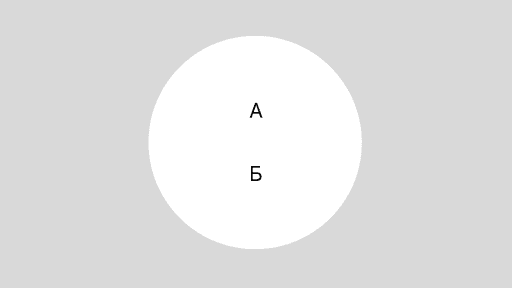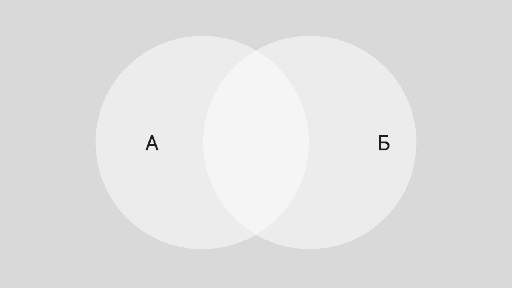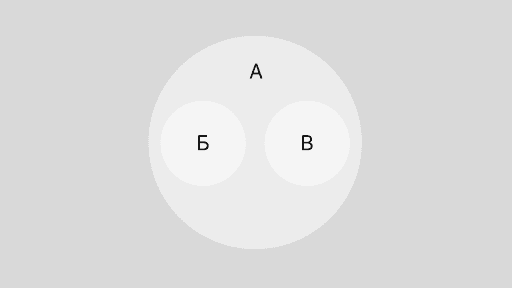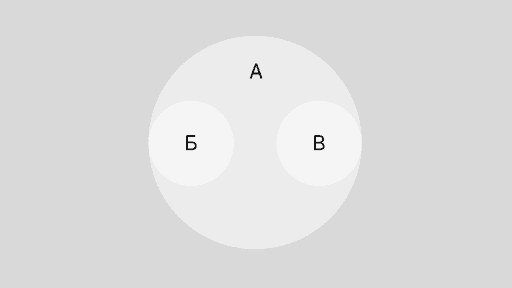
Relations between concepts in logic
Relations between concepts in logic

Explanation
upd
10/13/23
Precisely
Simpler
Shorter
Main thing
Relations between concepts in logic describe how different concepts are connected or associated with each other. There are two broad categories of relations: compatible and incompatible.
Compatible relations occur when the concepts can coexist without conflict. This includes:
Equivalence - Two concepts have exactly the same meaning and scope, representing the same set of instances. For example, 'bachelor' and 'unmarried man' are equivalent concepts.

Intersection - The concepts overlap partially, sharing some common instances but each also having some unique instances. Like 'vegetables' and 'green foods' - some vegetables are green foods, some are not, and some green foods are not vegetables.

Subordination - One concept is a specific type or subset contained entirely within the broader, more general concept. For instance, 'square' is a subordinate of the concept 'rectangle'.

Incompatible relations occur when the concepts cannot logically coexist or are contradictory. This includes:
Co-subordination - Two concepts are separate, distinct subsets of a broader concept with no overlap between them. For example, 'red' and 'blue' are co-subordinate under the concept of 'color'.

Proto-displacement - One concept originated from the other but has taken on a new, distinct meaning over time. Like 'awful' originally meant 'inspiring awe' but now means 'extremely bad/unpleasant'.

Contradiction - The concepts are mutually exclusive and cannot be jointly true. Such as 'living' and 'dead' for a single organism.

Terms
Concept - An abstract idea or mental representation of a group of instances/objects that share common characteristics. Example: The concept of 'chair' represents the idea of a seat with a back support.
An analogy
Relations between concepts are like relationships between people - some get along compatibly, others conflict. Just as friends are compatible, enemies contradict each other.
A main misconception
Many confuse intersection with equivalence. For example, thinking all vegetables are green foods and vice versa. But some vegetables are not green, and some green foods are not vegetables.
The history
Ancient Greek philosophers like Aristotle (384-322 BC) first systematically studied relations between concepts.
In the 9th century, Muslim logicians like Al-Farabi expanded on Aristotle's work.
In the 13th century, European scholastic philosophers further developed the topic.
In the 19th century, developments in symbolic logic by Gottlob Frege and others allowed more precise analysis.
In the 20th century, logicians like W.V.O. Quine made key contributions to understanding relations.
"Logic is the anatomy of thought." - John Locke, influential Enlightenment philosopher
Three cases how to use it right now
Classifying items in a grocery store based on their relations (e.g. putting all vegetables together as subordinates of produce).
Resolving conflicting instructions by identifying contradictory concepts (e.g. cannot open and close a door simultaneously).
Designing a product taxonomy for an e-commerce website by organizing concepts into compatible and incompatible groups.
Interesting facts
The word "concept" derives from the Latin "concipere" meaning to conceive or take in.
Venn diagrams, invented in 1880, are widely used to visualize relations between concepts.
The philosophical problem of universals concerns the metaphysical status of abstract concepts.
Thesauruses group words based on semantic concept relations like synonymy and antonymy.
Conceptual metaphors allow humans to understand abstract concepts in terms of more concrete ones.
Main thing
Relations between concepts in logic describe how different concepts are connected or associated with each other. There are two broad categories of relations: compatible and incompatible.
Compatible relations occur when the concepts can coexist without conflict. This includes:
Equivalence - Two concepts have exactly the same meaning and scope, representing the same set of instances. For example, 'bachelor' and 'unmarried man' are equivalent concepts.

Intersection - The concepts overlap partially, sharing some common instances but each also having some unique instances. Like 'vegetables' and 'green foods' - some vegetables are green foods, some are not, and some green foods are not vegetables.

Subordination - One concept is a specific type or subset contained entirely within the broader, more general concept. For instance, 'square' is a subordinate of the concept 'rectangle'.

Incompatible relations occur when the concepts cannot logically coexist or are contradictory. This includes:
Co-subordination - Two concepts are separate, distinct subsets of a broader concept with no overlap between them. For example, 'red' and 'blue' are co-subordinate under the concept of 'color'.

Proto-displacement - One concept originated from the other but has taken on a new, distinct meaning over time. Like 'awful' originally meant 'inspiring awe' but now means 'extremely bad/unpleasant'.

Contradiction - The concepts are mutually exclusive and cannot be jointly true. Such as 'living' and 'dead' for a single organism.

Terms
Concept - An abstract idea or mental representation of a group of instances/objects that share common characteristics. Example: The concept of 'chair' represents the idea of a seat with a back support.
An analogy
Relations between concepts are like relationships between people - some get along compatibly, others conflict. Just as friends are compatible, enemies contradict each other.
A main misconception
Many confuse intersection with equivalence. For example, thinking all vegetables are green foods and vice versa. But some vegetables are not green, and some green foods are not vegetables.
The history
Ancient Greek philosophers like Aristotle (384-322 BC) first systematically studied relations between concepts.
In the 9th century, Muslim logicians like Al-Farabi expanded on Aristotle's work.
In the 13th century, European scholastic philosophers further developed the topic.
In the 19th century, developments in symbolic logic by Gottlob Frege and others allowed more precise analysis.
In the 20th century, logicians like W.V.O. Quine made key contributions to understanding relations.
"Logic is the anatomy of thought." - John Locke, influential Enlightenment philosopher
Three cases how to use it right now
Classifying items in a grocery store based on their relations (e.g. putting all vegetables together as subordinates of produce).
Resolving conflicting instructions by identifying contradictory concepts (e.g. cannot open and close a door simultaneously).
Designing a product taxonomy for an e-commerce website by organizing concepts into compatible and incompatible groups.
Interesting facts
The word "concept" derives from the Latin "concipere" meaning to conceive or take in.
Venn diagrams, invented in 1880, are widely used to visualize relations between concepts.
The philosophical problem of universals concerns the metaphysical status of abstract concepts.
Thesauruses group words based on semantic concept relations like synonymy and antonymy.
Conceptual metaphors allow humans to understand abstract concepts in terms of more concrete ones.
Main thing
Relations between concepts in logic describe how different concepts are connected or associated with each other. There are two broad categories of relations: compatible and incompatible.
Compatible relations occur when the concepts can coexist without conflict. This includes:
Equivalence - Two concepts have exactly the same meaning and scope, representing the same set of instances. For example, 'bachelor' and 'unmarried man' are equivalent concepts.

Intersection - The concepts overlap partially, sharing some common instances but each also having some unique instances. Like 'vegetables' and 'green foods' - some vegetables are green foods, some are not, and some green foods are not vegetables.

Subordination - One concept is a specific type or subset contained entirely within the broader, more general concept. For instance, 'square' is a subordinate of the concept 'rectangle'.

Incompatible relations occur when the concepts cannot logically coexist or are contradictory. This includes:
Co-subordination - Two concepts are separate, distinct subsets of a broader concept with no overlap between them. For example, 'red' and 'blue' are co-subordinate under the concept of 'color'.

Proto-displacement - One concept originated from the other but has taken on a new, distinct meaning over time. Like 'awful' originally meant 'inspiring awe' but now means 'extremely bad/unpleasant'.

Contradiction - The concepts are mutually exclusive and cannot be jointly true. Such as 'living' and 'dead' for a single organism.

Terms
Concept - An abstract idea or mental representation of a group of instances/objects that share common characteristics. Example: The concept of 'chair' represents the idea of a seat with a back support.
An analogy
Relations between concepts are like relationships between people - some get along compatibly, others conflict. Just as friends are compatible, enemies contradict each other.
A main misconception
Many confuse intersection with equivalence. For example, thinking all vegetables are green foods and vice versa. But some vegetables are not green, and some green foods are not vegetables.
The history
Ancient Greek philosophers like Aristotle (384-322 BC) first systematically studied relations between concepts.
In the 9th century, Muslim logicians like Al-Farabi expanded on Aristotle's work.
In the 13th century, European scholastic philosophers further developed the topic.
In the 19th century, developments in symbolic logic by Gottlob Frege and others allowed more precise analysis.
In the 20th century, logicians like W.V.O. Quine made key contributions to understanding relations.
"Logic is the anatomy of thought." - John Locke, influential Enlightenment philosopher
Three cases how to use it right now
Classifying items in a grocery store based on their relations (e.g. putting all vegetables together as subordinates of produce).
Resolving conflicting instructions by identifying contradictory concepts (e.g. cannot open and close a door simultaneously).
Designing a product taxonomy for an e-commerce website by organizing concepts into compatible and incompatible groups.
Interesting facts
The word "concept" derives from the Latin "concipere" meaning to conceive or take in.
Venn diagrams, invented in 1880, are widely used to visualize relations between concepts.
The philosophical problem of universals concerns the metaphysical status of abstract concepts.
Thesauruses group words based on semantic concept relations like synonymy and antonymy.
Conceptual metaphors allow humans to understand abstract concepts in terms of more concrete ones.
Materials for self-study
+ Suggest a material
Register to Use the Bookmarking Feature
By registering, you can:
Save materials for later (bookmarks)
Track your progress on roadmaps and blocks
Access selected medium and full roadmaps for free
Get notified about new roadmaps
Register to Use the Bookmarking Feature
By registering, you can:
Save materials for later (bookmarks)
Track your progress on roadmaps and blocks
Access selected medium and full roadmaps for free
Get notified about new roadmaps
Register to Use the Bookmarking Feature
By registering, you can:
Save materials for later (bookmarks)
Track your progress on roadmaps and blocks
Access selected medium and full roadmaps for free
Get notified about new roadmaps
Check exercise
You are a product manager for a company that is considering launching a new line of organic snacks. You have three different concepts in mind: Organic fruit chews that are sweetened with honey Organic granola bars with nuts and seeds Organic chips made from lentils and quinoa Categorize each snack concept based on the logical relations between them.
Register to Track Your Progress
By registering, you can:
Save materials for later (bookmarks)
Track your progress on roadmaps and blocks
Access selected medium and full roadmaps for free
Get notified about new roadmaps
Register to Track Your Progress
By registering, you can:
Save materials for later (bookmarks)
Track your progress on roadmaps and blocks
Access selected medium and full roadmaps for free
Get notified about new roadmaps
Register to Track Your Progress
By registering, you can:
Save materials for later (bookmarks)
Track your progress on roadmaps and blocks
Access selected medium and full roadmaps for free
Get notified about new roadmaps
Updates
Subscribe to Use Updates Feature
By subscribing, you can:
Access all roadmaps
Access updates for blocks and roadmaps
Get feedback to your answers for exercises
Consult with experts for guidance
Order a custom block or roadmap monthly
Conversation with premium AI
Subscribe to Use Updates Feature
By subscribing, you can:
Access all roadmaps
Access updates for blocks and roadmaps
Get feedback to your answers for exercises
Consult with experts for guidance
Order a custom block or roadmap monthly
Conversation with premium AI
Subscribe to Use Updates Feature
By subscribing, you can:
Access all roadmaps
Access updates for blocks and roadmaps
Get feedback to your answers for exercises
Consult with experts for guidance
Order a custom block or roadmap monthly
Conversation with premium AI
Roadmaps where it's used
Related blocks
Share